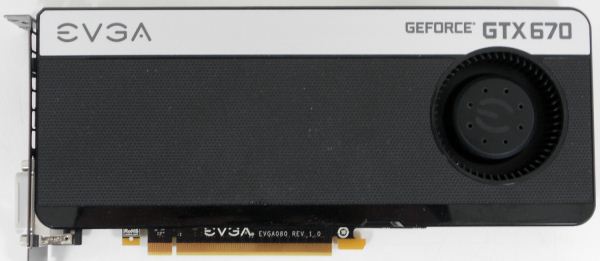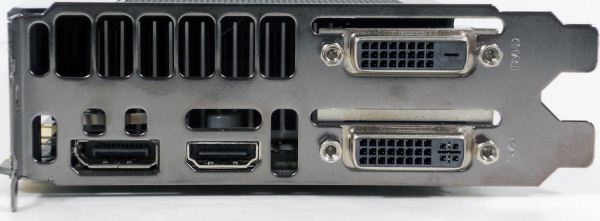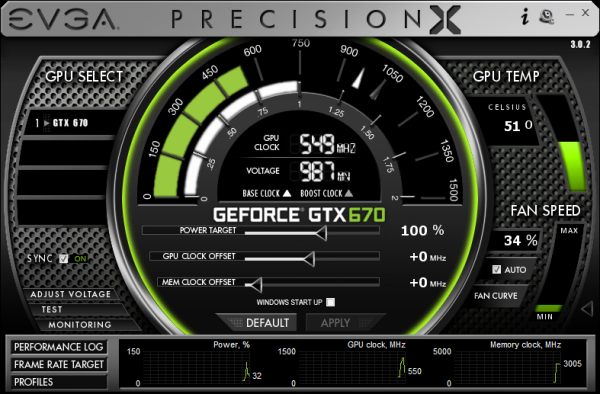NVIDIA GeForce GTX 670 Review Feat. EVGA: Bringing GK104 Down To $400
by Ryan Smith on May 10, 2012 9:00 AM ESTMeet The EVGA GeForce GTX 670 Superclocked
Our second card of the day is EVGA’s GeForce GTX 670 Superclocked, which in EVGA’s hierarchy is their first tier of factory overclocked cards. EVGA is binning GTX 670s and in turn promoting some of them to this tier, which means the GTX 670 Superclocked are equipped with generally better performing chips than the average reference card.
| GeForce GTX 670 Partner Card Specification Comparison | ||||
| EVGA GeForce GTX 670 Superclocked | GeForce GTX 670 (Ref) | |||
| CUDA Cores | 1344 | 1344 | ||
| Texture Units | 112 | 112 | ||
| ROPs | 32 | 32 | ||
| Base Clock | 967MHz | 915MHz | ||
| Boost Clock | 1046MHz | 980MHz | ||
| Memory Clock | 6210MHz | 6008MHz | ||
| Memory Bus Width | 256-bit | 256-bit | ||
| Frame Buffer | 2GB | 2GB | ||
| TDP | 170W | 170W | ||
| Manufacturing Process | TSMC 28nm | TSMC 28nm | ||
| Width | Double Slot | Double Slot | ||
| Length | 9.5" | 9.5" | ||
| Warranty | 3 Years | N/A | ||
| Price Point | $419 | $399 | ||
For the GTX 670 SC, EVGA has given both the core clock and memory clock a moderate boost. The core clock has been increased by 52MHz (6%) to 967MHz base and 66MHz (7%) boost to 1046MHz. Meanwhile the memory clock has been increased by 202MHz (3%) to 6210MHz.
Other than the clockspeed changes, the GTX 670 SC is an almost-reference card utilizing a reference PCB with a slightly modified cooler. EVGA is fabricating their own shroud, but they’ve copied NVIDIA’s reference shroud down to almost the last detail. The only functional difference is that the diameter of the fan intake is about 5mm less, otherwise the only difference is that EVGA has detailed it differently than NVIDIA and used some rounded corners in place of square corners.
The only other change you’ll notice is that EVGA is using their own high flow bracket in place of NVIDIA’s bracket. The high flow bracket cuts away as much metal as possible, maximizing the area of the vents. Though based on our power and temperature readings, this doesn’t seem to have notably impacted the GTX 670 SC.
While we’re on the matter of customized cards and factory overclocks, it’s worth reiterating NVIDIA’s position on factory overclocked cards. Reference and semi-custom cards (that is, cards using the reference PCB) must adhere to NVIDIA’s power target limits. For GTX 670 this is a 141W power target, with a maximum power target of 122% (170W). Fully custom cards with better power delivery circuitry can go higher, but not semi-custom cards. As a result the flexibility in building semi-custom cards comes down to binning. EVGA can bin better chips and use them in cards such as the Superclocked – such as our sample which can go 17 boost bins over the base clock versus 13 bins for our reference GTX 670 – but at the end of the day for stock performance they’re at the mercy of what can be accomplished within 141W/170W.
In any case, as the card is otherwise a reference GTX 670 EVGA is relying on the combination of their factory overclock, their toolset, and their strong reputation for support to carry the card. EVGA has priced the card at $419, $20 over the GTX 670 MSRP, in-line with other factory overclocked cards.
On the subject of pricing and warranties, since this is the first EVGA card we’ve reviewed since April 1st, this is a good time to go over the recent warranty changes EVGA has made.
Starting April 1st, EVGA has implemented what they’re calling their new Global Warranty Policy. Starting July 1st, 2011 (the policy is being backdated), all new EVGA cards ship with at least a 3 year warranty. And for the GTX 600 series specifically, so far EVGA has only offered models with a 3 year warranty in North America, which simplifies their product lineup.
To complement the 3 year warranty and replace the lack of longer term warranties, EVGA is now directly selling 2 and 7 year warranty extensions, for a total of 5 and 10 years respectively. So instead of buying a card with a 3 year warranty or a longer warranty, you’ll simply buy the 3 year card and then buy a warranty extension to go with it. However the extended warranty requires that the card be registered and the warranty purchased within 30 days.
The second change is that the base 3 year warranty no longer requires product registration. EVGA has other ways to entice buyers into registering, but they’ll now honor all applicable cards for 3 years regardless of the registration status. At the same time the base 3 year warranty is now a per-product warranty (e.g. a transferable warranty) rather than per-user warranty, so the base warranty will transfer to 2nd hand buyers. The extended warranties however will not.
The third change is how EVGA is actually going to handle the warranty process. First and foremost, EVGA is now allowing cards to be sent to the nearest EVGA RMA office rather than the office for the region the card was purchased from. For example a buyer moving from Europe to North America can send the card to EVGA’s North American offices rather than sending it overseas.
Finally, EVGA is now doing free cross shipping, alongside their existing Advanced RMA program. EVGA will now cross-ship replacement cards for free to buyers. The buyer meanwhile is responsible for paying to ship the faulty card back and putting up collateral on the new card until EVGA receives the old card.
There’s also one quick change to the step-up program that will impact some customers. With the move to purchasing extended warranties, the step-up program is only available to customers who either purchase an extended warranty or purchase an older generation card that comes with a lifetime warranty. Step-up is not available to cards with only the base 3 year warranty.
Moving on, along with EVGA’s new warranty EVGA is bundling the latest version of their GPU utilities, Precision X and OC Scanner X.
Precision X, as we touched upon quickly in our GTX 680 review, is the latest iteration of EVGA’s Precision overclocking & monitoring utility. It’s still based on RivaTuner and along with adding support for the GTX 600 series features (power targets, framerate caps, etc), it also introduces a new UI. Functionality wise it’s still at the top of the pack along with the similarly RivaTuner powered MSI Afterburner. Personally I’m not a fan of the new UI – circular UIs and sliders aren’t particularly easy to read – but it gets the job done.
OC Scanner X has also received a facelift and functionality upgrade of its own. Along with its basic FurMark-ish stress testing and error checking, it now also offers a basic CPU stress test and GPU benchmark.



















414 Comments
View All Comments
Morg. - Thursday, May 10, 2012 - link
No.I am saying that tahiti XT paired with 384 bits RAM AND clocked at the same speed as a gtx 680 paired with 256 bits RAM, has clearly more raw power.
The thing is, two years from now, nVidia will be boosting other new games for the NEW nVidia hardware and you will not benefit from it on the old H/W.
However, raw power will remain, 3GB of RAM will still be 3GB of RAM and you will thank god for the added graphics you get out of that last 1 GB that cost you nothing more.
The two games that have for years been GPU benchmarks and haven't been sponsored by either nVidia or AMD are Crysis warhead and metro 2033.
If you wanna trash those results because BF3 is everything to you, you should totally do it though.
scook9 - Thursday, May 10, 2012 - link
Crysis: Warhead is a "The way it is meant to be played" title.....You see that every time you start it up as well as on the box.
http://image.com.com/gamespot/images/bigboxshots/3...
eddman - Thursday, May 10, 2012 - link
Two years from now 7970 won't be powerful enough anyway.As scook9 mentioned, warhead is an TWIMTBP and yet runs better on 7970.
It'd be better if you removed that tin foil hat. TWIMTBP and Gaming Evolved are programs to help developers code their games better.
There are countless TWIMTBP games that run better on radeons.
Crysis and warhead use an old engine that isn't going to be used anymore. Nowadays they are just obsolete benchmarks.
Metro 2033 is a very nice game and I really liked it, but it's not that popular and has a proprietary engine. Most gamers don't care about such engine.
Frostbite, OTOH, matters because it belongs to a major publisher/developer which means we'll see many games based on it in the future.
SlyNine - Thursday, May 10, 2012 - link
I'm pretty sure a 4870 (basically a 6770) is powerful enough today, why wouldn't a 7970 be powerful enough by than.Just because an engine is going to be used anymore doesn't mean it isn't useful to gauge certain aspects of a videocard. Many engines that will be used are not even developed yet, some may push a card more like the Crytech engine did.
Crytech 2 is going to be used for MechWarrior online baby. (Im glad it used a good engine, and it looks like they are using it to good effect).
eddman - Thursday, May 10, 2012 - link
Because 3GB memory is for high-resolutions and high AA settings, and 2 years from now 7970 won't have enough power to run those games at those settings at good frame rates.That doesn't make sense. Card A might run max payne 1 twice as fast as card B, but what'd be the point.
No, mechwarrior online uses cryengine 3, not 2. Cryengine 2, that was used in crysis and warhead, is dead.
SlyNine - Saturday, May 12, 2012 - link
I meant CryEngine 3. not sure why I said 2.There is no proof that 3gigs wont be enough for high res by then. Yea maybe not (or maybe) with AA.
Besides you didn't say anything about running maxed out everything, you made a blanket statement that the 7970 wont powerful enough period.
That means that card A does something that card B cannot, depending on what that is it have an effect on engines that focus on certain things.
eddman - Saturday, May 12, 2012 - link
I meant 7970 won't have enough shader power 2 years from now, so 3GB won't help then either.Yes, everything maxed out with high AA. After all that's what large memories are for.
Obsolete engine is obsolete. Deal with it. Cryengine 2 won't be used in any other AAA game. It's gone.
SlyNine - Saturday, May 12, 2012 - link
A realtime engine will always tell you something about the card. Obsolete or not.If 3GB gives it some sort of advantage then it was worth it. In many games it's already showing an advantage at ultra high res.
Only you are saying the only use of large video cache is AA at ultra settings. But this is simply a questionable premise.
I really don't care if Cryengine 2 is used for a AAA game, or ever again. I still play Crysis. Furthermore I don't give a dam about AAA games, most of them are dumbed down for mass appeal.
CeriseCogburn - Monday, June 11, 2012 - link
At 7000X what rez is 3GB showing an advantage ?ROFL - desperation
theprodigalrebel - Thursday, May 10, 2012 - link
BF3 has sold 1.9 million copies worldwide.Metro 2033 has sold 0.16m copies worldwide
Crysis is an old game that I don't see (m)any people playing.
BF3 is also scheduled for three DLC releases (two this year, third next year).
I see a perfectly good reason why BF3 performance matters. You are speculating that the 7900-series will have great Unreal 4 performance. That's just silly since nobody knows anything about Unreal 4 performance yet.
The only thing I could find was Hexus.net reporting that nVidia chose the Kepler to demonstrate the Unreal 4 engine at the GDC.